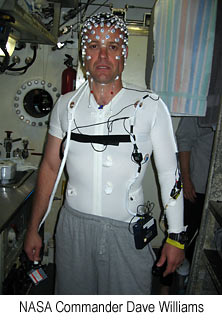Exploring Inner Space in Outer Space
- Using Biofeedback
By Rob Kall
 What motivates an astronaut, an outer space explorer, to spend a lot of time under water in an underwater habitat? The answer is, it's a great way to simulate many aspects of zero gravity living and long term confinement that are experienced in space vehicles and stations.
What motivates an astronaut, an outer space explorer, to spend a lot of time under water in an underwater habitat? The answer is, it's a great way to simulate many aspects of zero gravity living and long term confinement that are experienced in space vehicles and stations.
For decades, NASA has been studying astronaut's physiological responses to being exposed to zero gravity, to living in outer space and to staying in a space vehicles and space stations for extended periods of time. Researchers William Toscano and Pat Cowing have been doing this kind of research for several decades. Some of their most interesting work has involved researching the problem of Zero Gravity illness, which is sort of like car or sea-sickness. It's a common problem among astronauts.
Just recently, Toscano and Cowing have been doing research under water, since the environment provides some useful similarities to working in space. They developed, using off the shelf technology, a wearable outfit that records multiple physiological measurements simultaneously. The technology is ultra miniaturized, using a standard FlexComp Infiniti™ physiological encoder, storing the data using flash memory cards. The astronauts, Commander Dave William, a Canadian Physician, and Ron Garin, an American, wore the "gear" throughout the day while living in an NOAA (National Oceanic and Atmospheric Administration) undersea habitat, off the shore of Key Largo Florida, 65 feet down, below the surface.
Toscano described the mission, "Our project was called Nemo Nine. It was 22 days long, with 2 astronauts participating. They wore the FlexComp Infiniti™ system for three of the mission days. What we were looking for was to look for the effect of isolation, workload and fatigue on the individuals. It was all stored on flash memory cards. We recorded five measurements-- Heart rate and electrocardiogram, Respiration, Skin conductance, hand temperature and finger pulse volume. Throughout the day they had activities and tasks to do."
Toscano explained, "We're using that (the Nemo nine) environment as an analog of a space station. It's a good one. NASA occasionally gets an opportunity to send astronauts down there. Other ideal environments would be south pole studies, people going on long term expeditions which would be akin to long term for space."
New, microminiaturization technologies have enabled the NASA researchers to use commercially produced biomedical devices like the FlexComp Infiniti™to do what used to take a wall full of equipment easily weighing over 1000 pounds. Now, the device, manufactured by Thought Technology, weighs less than a pound and has built-in data storage using flash memory cards.
Dr. Toscano reported that there were many simultaneous studies going on, including telemedicine, team decision-making, telerobotics, human performance studies, sleep studies looking at sleep wake cycles. He described, "We're looking at stress reactions, so we have basically the timeline of the crew and what they were doing throughout a mission day. We'll also have video and audio information so we can correlate the physiology with what is going on and we've also collected data on them before they went down, so we have normal work environment data.
The scientists, in the necessary tradition of many NASA missions, were not there to operate the equipment. "We had the equipment and shipped it down there, trained them how to use it and off they went. This was worn by astronauts for an eight hour day. We had a training manual, showed them procedures, how to put it on. We had a special suit designed to restrain all the cabling. The cable harness, looked like an undershirt with all the cables," described Toscano. "The data was stored on flash memory cards, they (the astronauts) would change it out each day they recorded. They would swap out the batteries, put on new electrodes, as needed. They took them off during dives," he explained, since they didn't want to deal with sealing the gear.
Toscano commented on the extreme research environment, on the air pressure "at 65 feet is about 2.65 (atmospheres) -- different from at the surface. There were questions of whether the instrument would function, would it work. And it did.
Overall, Toscano reports that they were very pleased with the research project and look forward to further work with the technology. In the past, he and his research partner, Patricia Cowing have developed and patented a biofeedback aided technique for helping astronauts cope with Zero Gravity illness. The process was tested by training astronauts BEFORE they went on a space shuttle mission. This was a case of taking research and turning it into something practical, that worked. Zero Gravity illness in outer space can be very debilitating.


